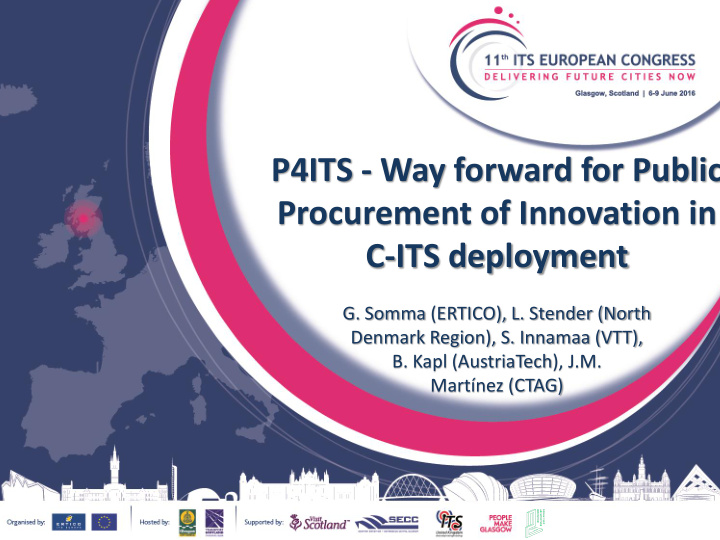



P4ITS - Way forward for Public Procurement of Innovation in C-ITS deployment G. Somma (ERTICO), L. Stender (North Denmark Region), S. Innamaa (VTT), B. Kapl (AustriaTech), J.M. Martínez (CTAG)
The P4ITS Thematic Network Procurement of innovative C-ITS solutions to foster market roll-out Objectives: • Raise awareness about PPI • Mutual learning & training • Common approach amongst ITS purchasers • Recommendations / guidelines • Long term network to support daily work of future C-ITS procurers Achievements: • Common understanding on different PPI approaches (legal, IPR,...) • First-hand experiences on real cases / current practices in C-ITS • Final recommendations for policy makers and public procurers
Common understanding on PPI PCP: contracting authorities to steer the development of solutions towards concrete public sector needs, whilst comparing / validating alternative solution approaches from various vendors research, development, validation PPI: contracting authorities to act as launching customer / early adopter / first buyer of innovative commercial end-solutions (goods or services) newly arriving on the market (pilot) deployment Source: http://ec.europa.eu/digital-agenda/en/innovation-procurement
Common understanding on PPI Market consultation / investigation New innovative NO “Conventional” public procurement solution needed or without innovation welcomed? End of Innovation Procurement (PCP / PPI) YES Does the market offer a new solution, service or technology that might fulfil YES your needs? Or might existing solutions, services or technology/ – after some modification or adaption – fulfil your More R&D needs? YES NO for adaption PPI without R&D PPI with R&D or integration R&D (e.g., PCP) needed ? NO Procurement of TRL 1 TRL 2 TRL 3 TRL 4 TRL 5 TRL 6 TRL 7 TRL 8 TRL 9 COTS Basic Technology Experimental Tech. validation Tech. validation Technology System/prototype System Actual system Commercial principles concept proof of in lab (small scale in relevant demostration demonstration complete proven in Off The Shelf observed formulated concept prototype) environment (large in relevant in operational and operational (available on scale prototype) environment environment qualified environment the market)
Common understanding on PPI PPI flowchart: • intended as a conceptual reference for public procurers of (C-)ITS and their counterparts • aiming to identify different types of procurement in relation to C-ITS development level • not encompassing any specific procedure regulated by EU Directives / national legislation PPI understood as: • Policy mix encouraging the procurement of both R&D and innovation : A. programmes/strategies/policies making daily procurement innovation friendly, supporting joint procurement actions and market penetration of novel solutions; B. approaches enhancing possibilities of new innovative solutions to enter the market; PPI approaches may be used in any public procurement procedure, including day-to-day ‘conventional’ procurement, to enhance the possibilities for obtaining new solutions able to meet the needs of the procuring authority.
First-hand experiences on real cases / current practices in C-ITS • Day 1 services C-ITS technology & prototypes mature (up to TRL 7), COTS available in some cases, but no commercial volumes! • Day 1.5 services now at TRL 5-6, higher chances to be further developed and fully deployed by means of PPI actions. Larg rge e scale, ale, harm armon oniz ized d deploy ployment nt (TEN-T, CEF, Interreg, Struct. Funds) Pilot ot deploy ploymen ent, spec ecif ific ication, ion, (Compass4D, CO-GISTICS, NordicWay, ECo-AT, SCOOP@F) EU Field eld Tests (Drive C2X, FOTSIS) Field eld Opera eratio iona nal l Tes ests (Pre-DRIVE, small prototyping) Resear earch & Develo elopm pment nt (COOPERS, CVIS, SAFESPOT) 2006 2016 2010
C-ITS development / deployment built around a PPI approach 2 3 Development & Testing Implementation PPI 1 4 Need / Requirement / Optimisation Specification 5 Deployment
Way forward in deployment Match? Operators Industry • Improve • Sell Technology USERS Infrastructure • Run „New • Quality of Service Business“ We need to go „ beyond projects “ From a project-driven landscape to sustainable operation and effective use of Infrastructure
A QUESTION OF SPEED TELCOs OEMs Public Authorities + A QUESTION OF RESPONSIBILITIES
Oper- Smart Governance ators, PA Smart Financing/ Procurement Business models SMEs/ User Industry Start ups (co-)operation models Products, services Social Innovation Real life test scenarios, Code RTOs of Practice (CoP) Academia Mobility as an innovation eco-system
Conclusions • PPI not a complex set-up of procedures, difficult to implement • PPI mix of strategies & approaches enabling decision makers and public procurers to communicate needs / issues of public authorities and users to commercial players and consult the market prior to any acquisition. • PPI opportunity to find new solutions while gathering reciprocal knowledge important on mid-/long-term policy, implementation plans and operational needs of procurers as well as on technology/service evolution of commercial actors, while reducing risk of potential vendor/ technology lock-in. • PPI opportunity for public authorities to steer cooperation between private companies and research organisations and speed up large scale deployment process and market uptake • PPI opportunity to bring C-ITS into the arena of innovative thinkers from other ICT sectors and, possibly, radically new approaches and disruptive business models and sustainable market solutions. • PPI to improve the quality / efficiency of services • PPI to support innovative companies (start-ups) • PPI to incentivize companies to invest in innovation
Thank you for your attention! http://p4its.eu/ Giacomo Somma g.somma@mail.ertico.com Competitiveness and Co-financed by the Innovation Programme European Union ICT-PSP
Recommend
More recommend